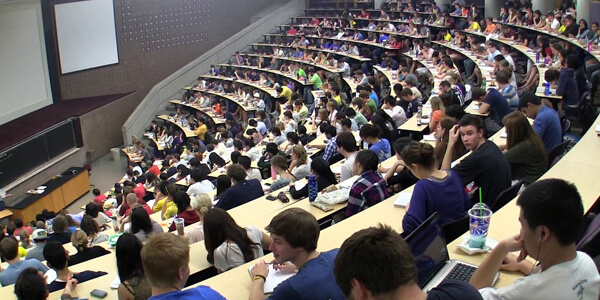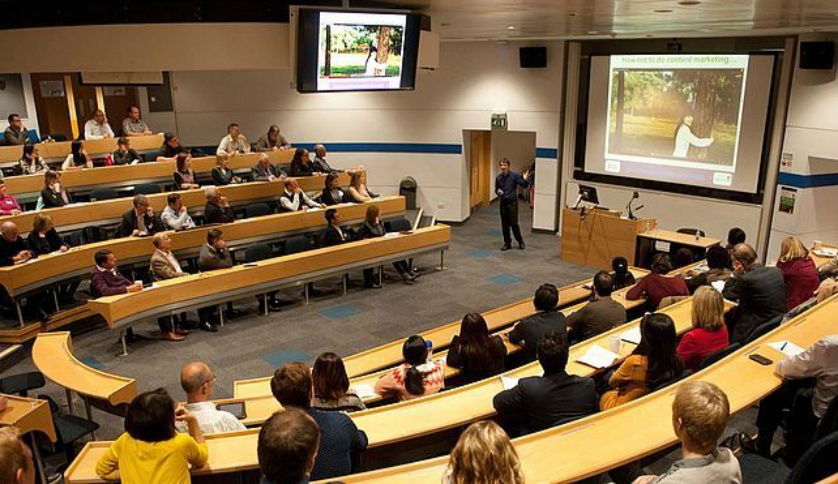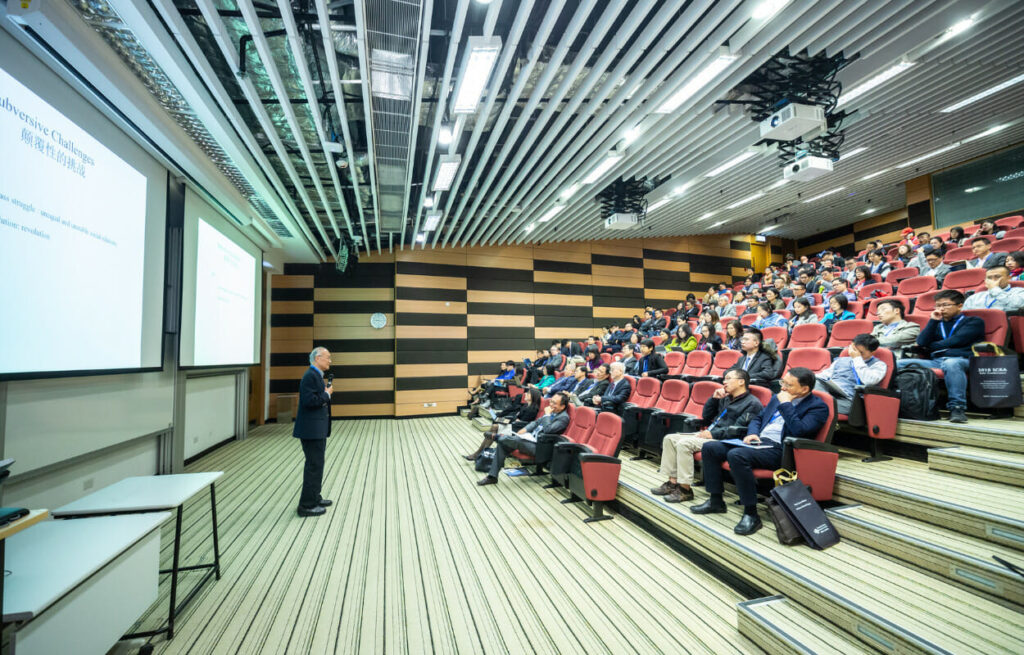Lectures and seminars represent distinct approaches to learning. In a lecture, a teacher delivers information to a large audience, often in a one-way communication style. Students listen, take notes, and absorb new content. They are more formal and typically involve less student interaction.
On the other hand, seminars are smaller, fostering a collaborative environment where students actively participate in discussions, group activities, and self-directed learning. The focus is on dialogue, allowing students to explore topics in-depth, share ideas, and engage in critical thinking.
Seminars often follow lectures, providing an opportunity for students to consolidate their understanding through group interactions. In essence, lectures are more about information delivery, while seminars emphasize active engagement, discussions, and a deeper exploration of the subject matter.
What Is a Lecture?

A lecture is a formal and structured presentation or speech delivered by an educator, expert, or speaker to a large audience. It’s a common method in higher education where a knowledgeable person imparts information, explanations, or insights on a specific topic.
The term “lecture” is derived from the Latin word “lectura,” meaning ‘to read aloud,’ reflecting historical practices of oral delivery.
In addition, during a lecture, the speaker usually stands in front of an audience, often in a lecture hall or auditorium. They convey information verbally, with visual aids like slides or multimedia, and sometimes demonstrations.
Also, The main aim of a lecture is to provide students with foundational knowledge, theories, and concepts related to a subject. This helps them understand key principles and frameworks.
Lectures involve a one-way flow of information from the speaker to the audience. However, they can include opportunities for questions and discussions, particularly toward the end.
Further, they play a crucial role in introducing new material and setting the groundwork for further exploration in seminars or other interactive learning formats.
What Is Seminars?
Seminars are small group sessions guided by a lecturer or facilitator. They involve interactive discussions, collaborative activities, and in-depth exploration of specific topics. Unlike larger lectures, seminars provide a more intimate setting, fostering active participation and personalized attention.
Moreover, they often build upon previous lecture content, aiming to deepen understanding and encourage critical thinking. They can include practical applications of knowledge, continuous assessments, and opportunities for students to seek feedback and clarification on course material.
Also, this format develops critical analysis, communication, and teamwork skills, enhancing the higher education learning experience.
What Is A Seminar According To Sources?
A seminar is a small group meeting, often held in an academic setting, where participants engage in discussion and exchange ideas on a specific topic.
Definition 1 (Race, 2005)
A seminar is characterized as a learning session where learners actively contribute the majority of the content. This involvement includes individual or small group preparations on pre-allocated topics, followed by opening those topics for group discussion.
Definition 2 (Becker and Denicolo, 2012)
A seminar is described as a gathering of students, typically ranging from 6 to 16 individuals, focused on discussing a specific aspect of a course or module. The discussion is led by one or occasionally two tutors.
Paraphrased Meaning
A seminar is an intimate group session where active participation is encouraged. Students, usually numbering around 15 or less, engage in discussions about the assigned learning material. These sessions often follow lectures, providing an opportunity for brainstorming and reflection on the topics presented.
What to Expect in Seminars
In seminars, you can typically expect the following.
Small Classes
It typically consists of small groups, with an average of around 15 students. Occasionally, class sizes can vary, reaching up to 45 students depending on university policies and resource allocation.
Moreover, dialogue Seminars prioritize discussions over lectures. Teachers introduce topics and facilitate, allowing students to share their ideas and engage in conversations.
Group Work
Group activities are common in seminars, with students often working together to explore assigned tasks or topics. Reports from small groups are then shared with the entire class.
Self-Directed Learning
It emphasizes self-directed learning, with minimal intervention from the teacher. Students are encouraged to explore topics critically, think from multiple perspectives, and discuss various angles.
Discussing Readings
Assigned readings, usually completed before the seminar, form the basis for discussion. Stimulus questions often revolve around these readings, requiring students to contribute insights.
Pop Tests
Pop quizzes can be used to ensure students are accountable for completing weekly readings. These tests encourage active engagement and preparation for class discussions.
Active Learning
Active participation is crucial in it. Students are expected to contribute to discussions actively, potentially influencing their peers’ perspectives. Various activities like debates, brainstorming, and experiments promote engagement.
Ask Questions
It offers the opportunity to interact closely with teachers. Students can seek clarification, ask questions about assignments, and gain insights into the teacher’s expectations.
Know Your Teacher
Building a closer relationship with the teacher is emphasized in seminars. Understanding the teacher’s preferences can be advantageous for assessments.
What Is A Lecture According To Sources?
A lecture is a form of educational instruction or discourse given by a teacher or instructor to students or an audience.
Definition 1 (Exley and Dennick, 2009)
A lecture is described as a speech presented to a large audience, often in a lecture theatre. It is considered the standard model of academic teaching and is derived from the Latin term ‘lectare,’ meaning ‘to read aloud.’
Definition 2 (Brown and Race, 2003)
Lecturing is portrayed humorously as engaging with a large audience to convey information, enthusiasm, and knowledge. It involves the teacher speaking to many people simultaneously, sometimes with a less engaged audience.
Paraphrased Meaning
A lecture is a large group session where the teacher is the central speaker. It involves one-way communication, with the teacher presenting information to students who listen and take notes.
What to Expect in Lectures
In a lecture, you can typically expect the following:
Large Classes
Lectures typically have a large audience, ranging from 40 to 200 students. Students from various majors can attend the same lecture.
Teacher as the Center of Attention
The teacher takes center stage in lectures. Students listen, observe, and take notes as the teacher presents information.
Learning by Listening
Passive learning is emphasized in lectures. Students absorb information by listening to the teacher’s explanations and stories.
Absorbing New Information
Lectures introduce new information, requiring students to absorb it and later apply it in related seminars.
Tips About Exams
They can provide hints or tips related to exams during lectures, incentivizing attendance and maintaining student attention.
Question Time at the End
Question sessions in lectures are usually reserved for the end. Students can ask for clarification or seek additional information.
Listening to Experts
Lecturers are often experts in their field, providing students with up-to-date and detailed information. Occasionally, external experts can be invited to deliver lectures.
What Is The Difference Between A Lecture And A Seminar?

| Feature | Lecture | Seminar |
| Class Size | Typically large, ranging from 40 to 200 students | Usually small, around 15 students on average |
| Interaction | One-way communication; teacher-centered | Two-way communication; student-centered |
| Discussion | Limited or no student discussions during the lecture | Emphasis on group discussions and student interaction |
| Group Activities | Rare; individual listening and note-taking | Common; often involves group work and discussions |
| Teacher’s Role | The central speaker imparts information | The facilitator guides discussions and activities |
| Learning Style | Passive; students absorb information | Active; students contribute to discussions actively |
| Self-Directed Learning | Limited, as the teacher directs the content | Emphasized, students explore topics on their own |
| Readings | Not always directly connected to the lecture content | Integral; often discussed and analyzed during the seminar |
| Pop Tests/Quizzes | Less common; assessments can be separate | Common; used to ensure preparation and engagement |
| Question Time | Reserved for the end; limited student questioning | Throughout; students can ask questions during discussions |
| Teacher-Student Interaction | Limited due to large class size | Close interaction; students can ask questions and seek advice |
| Exam Tips | Tips can be given, sometimes subtly, during the lecture | Not a focus; exams are often discussed more explicitly in lectures |
| Learning Environment | The formal setting focused on information delivery | An informal setting encourages active participation |
| Goal | Introduce new information for later application | Consolidate and discuss previously learned material |
FAQ’s
What is the difference between a seminar and a class?
Seminars provide a more detailed examination of a subject with increased student participation compared to class presentations.
What is the difference between a seminar and a presentation?
Seminars are interactive and collaborative, while presentations are typically more formal and one-way.
What is the difference between a lesson and a seminar?
Seminars involve group discussions or exercises based on specific topics, with students taking a lead role.
Final Words
The distinctions between lectures and seminars highlight the varied approaches to learning in higher education. Lectures deliver foundational information to many, fostering passive learning. Seminars encourage active engagement, discussions, and collaborative exploration in smaller groups.
Both lecture and seminar methods create a comprehensive educational experience. Lectures introduce information, while seminars allow interactive discussions and group activities for deeper understanding.
Further, each format offers unique benefits to learning, fostering a dynamic and comprehensive environment that caters to various aspects of knowledge acquisition.
